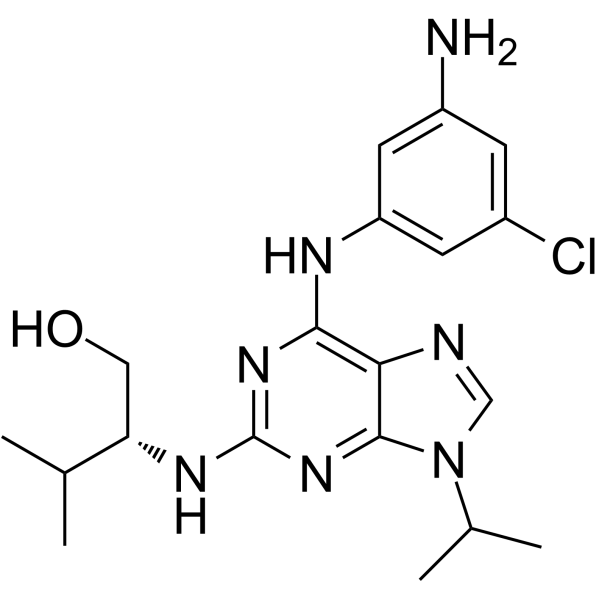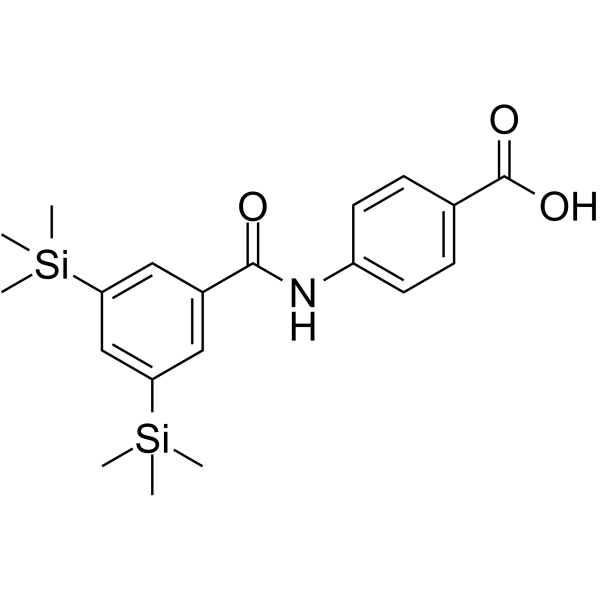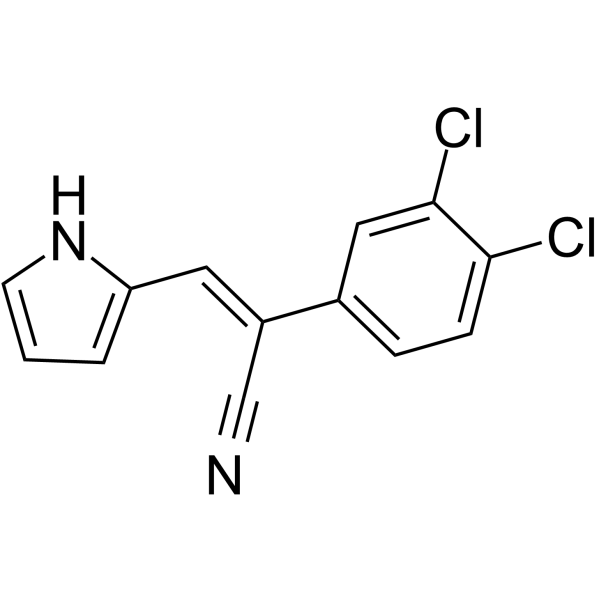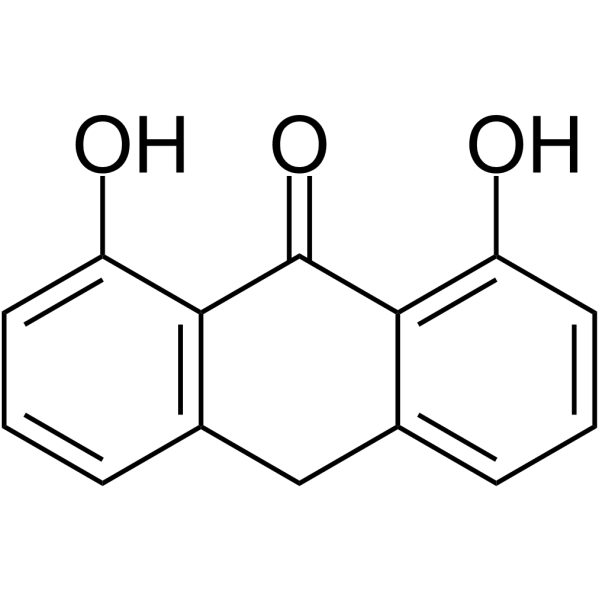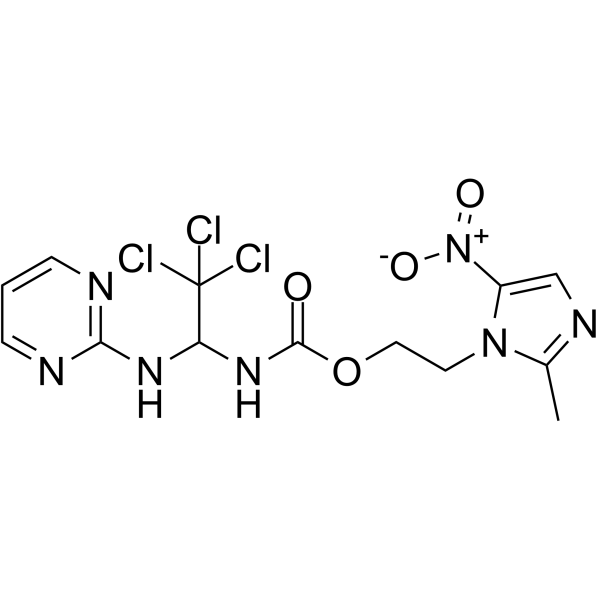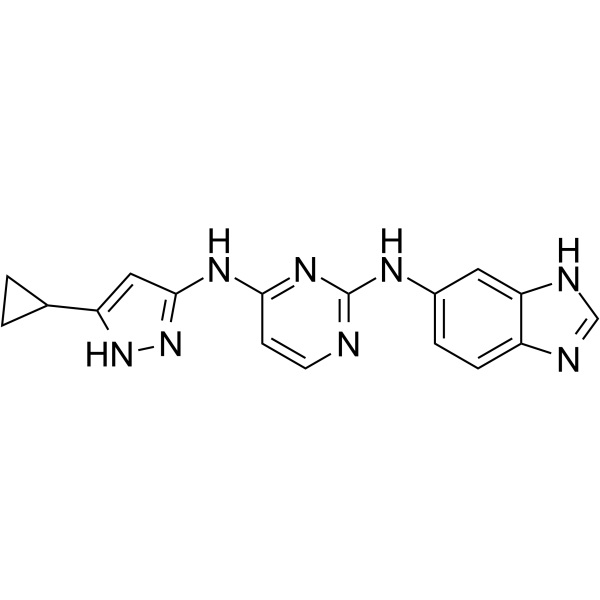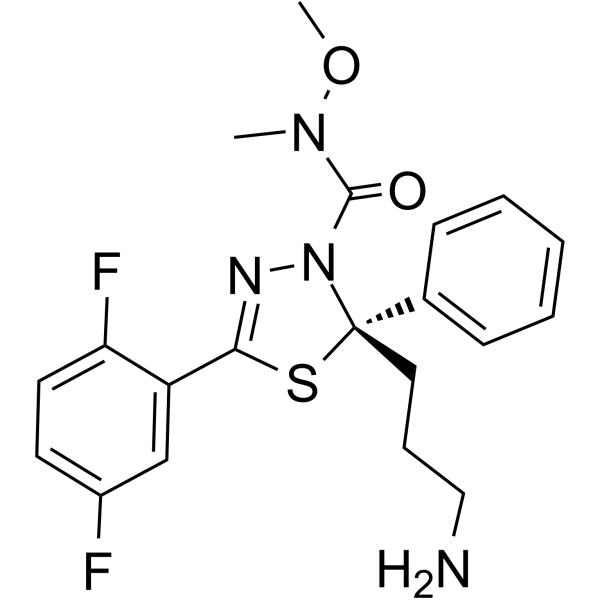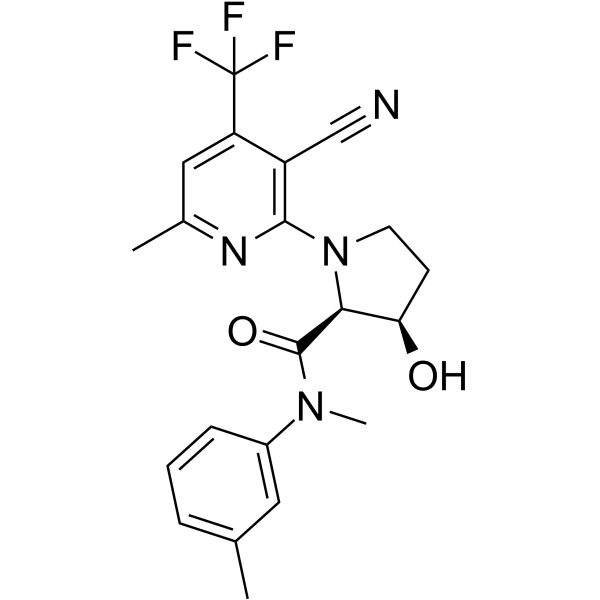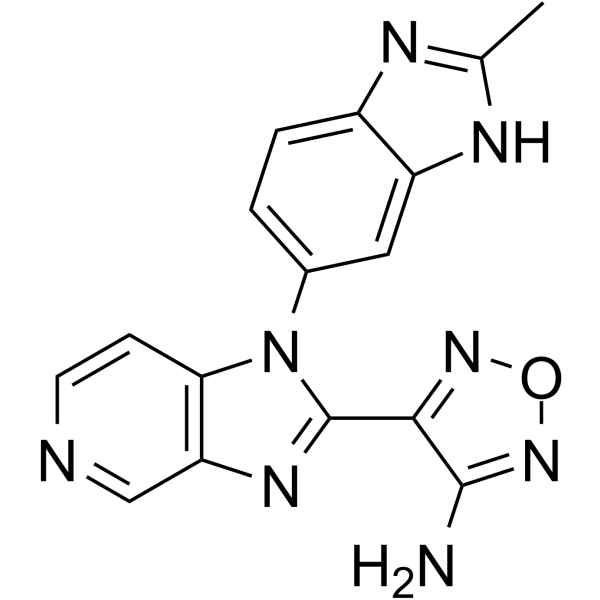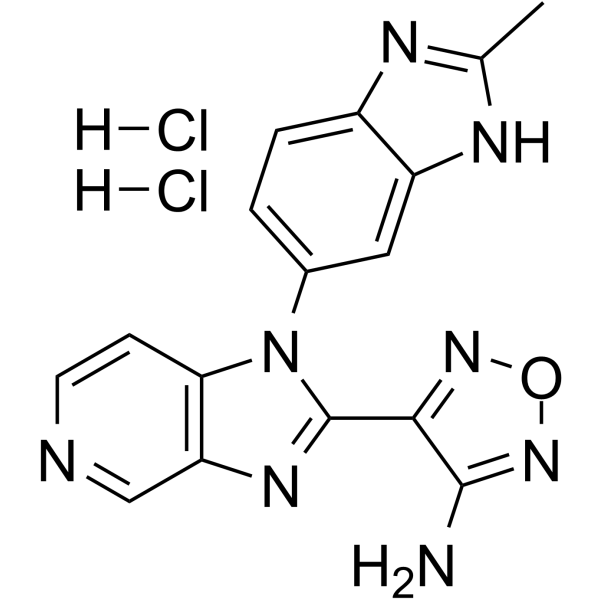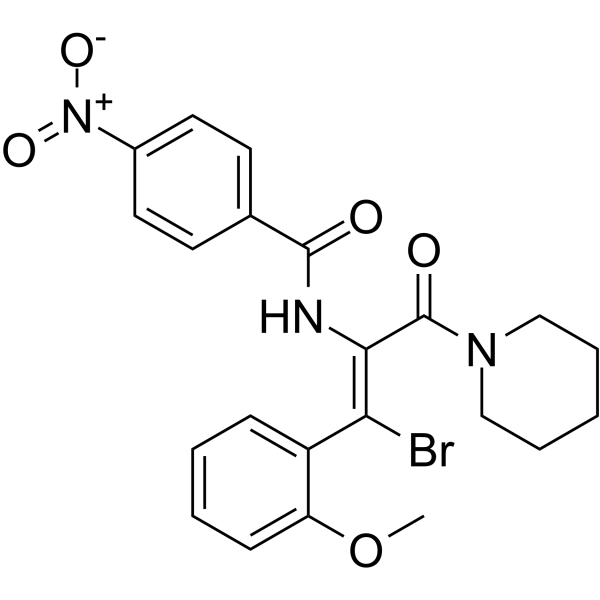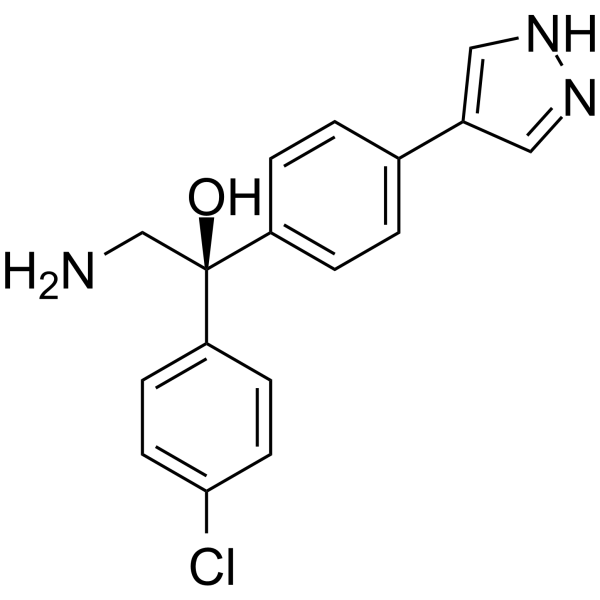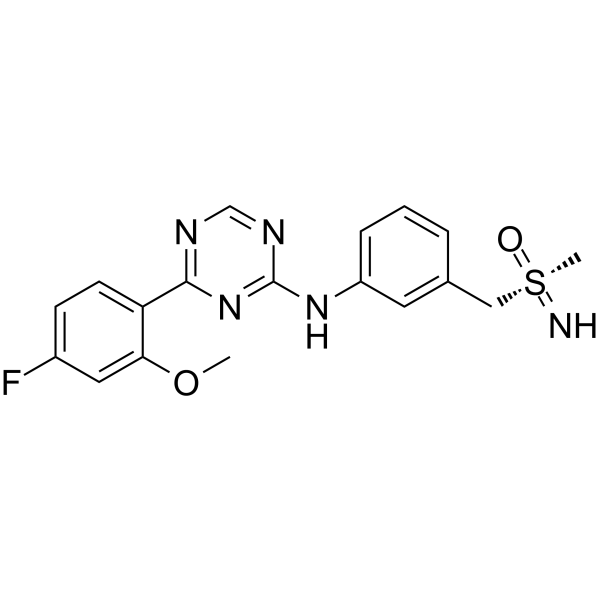|
BP13009
|
Aminopurvalanol A
|
|
|
|
|
Aminopurvalanol A is a competitive, selective and cell-permeable inhibitor of cyclin-dependent kinase (CDK) that potently inhibits Cyclin A/cdk2, Cyclin B/cdk1, Cyclin E/cdk2, and P35/cdk5 with IC50 of 33 nM, 33 nM, 28 nM and 20 nM, respectively.
|
|
BP13010
|
Amsilarotene
|
|
|
|
|
Amsilarotene inhibits the phosphorylation of retinoblastoma gene product (RB) and increases the presence of 2 cyclin-dependent kinases (CDK) inhibitors resulting in cell cycle arrest. This agent also causes a cytotoxic decline in the thymidylate synthase and cyclin A expression.
|
|
BP13011
|
ANI-7
|
|
|
|
|
ANI-7 is an activator of aryl hydrocarbon receptor (AhR) pathway. ANI-7 inhibits the growth of multiple cancer cells and potently and selectively inhibits the growth of MCF-7 breast cancer cells (GI50: 0.56 μM).
|
|
BP13012
|
Dithranol
|
|
|
|
|
Anthralin is an anthracene derivative that disrupts MITOCHONDRIA function and structure and is used for the treatment of DERMATOSES, especially PSORIASIS. It may cause FOLLICULITIS.
|
|
BP13013
|
ISOPIMPINELLIN
|
|
|
|
|
Antiviral, anti HIV.
|
|
BP13014
|
AOH1160
|
|
|
|
|
AOH1160 is an inhibitor of proliferating cell nuclear antigen (PCNA). AOH1160 induces apoptosis and causes cell-cycle arrest by interfering with DNA replication.
|
|
BP13015
|
Apcin A HCL
|
|
|
|
|
Apcin A HCL is an Apcin derivative. Apcin A HCL is an anaphase-promoting complex (APC) inhibitor. Apcin-A HCL interacts strongly with Cdc20, and inhibits the ubiquitination of Cdc20 substrates. Apcin-A HCL can be used to synthesize the PROTAC CP5V.
|
|
BP13016
|
Apcin
|
|
|
|
|
Apcin is a potent and competitive inhibitor of anaphase-promoting complex/cyclosome (APC/C(Cdc20)) E3 ligase activity. Apcin competitively inhibits APC/C-dependent ubiquitylation by binding to Cdc20 and preventing substrate recognition. It acts by blocking mitotic exit and being synergistically amplified by co-addition of Ts-Arg-OMe.
|
|
BP13017
|
Aplidine
|
|
|
|
|
Aplidine possesses antiviral activity against SARS-CoV-2(IC90 = 0.88 nM). Aplidine is a potent anti-cancer agent by targeting eukaryotic translation elongation factor 1 Alpha 2(EEF1A2, Kd = 80 nM).
|
|
BP13018
|
APY29
|
|
|
|
|
APY29 is an allosteric modulator of IRE1α; inhibits IRE1α autophosphorylation (IC50 = 280 nM) and activates IRE1α RNase activity.
|
|
BP13019
|
Ara-G
|
|
|
|
|
Ara-G is a deoxyguanosine (GdR) analog and a nucleoside analogue that is rapidly converted by cells of the T lymphoid lineage to its corresponding arabinosylguanine nucleotide triphosphate (araGTP), resulting in inhibition of DNA synthesis and selective in vitro toxicity to T lymphoblastoid cell lines as well as to freshly isolated leukemia cells from patients with T cell acute lymphoblastic leukemia (ALL).
|
|
BP13020
|
Aristolactam AIIIa
|
|
|
|
|
Aristolactam AIIIa is a new type of Plk1 inhibitors, targeting the Polo Box domain (PBD), it has anti-tumor activity. Aristolactam IIIa shows inhibition of platelet aggregation induced by collagen or arachidonic acid.
|
|
BP13021
|
ARRY 520 hydrochloride
|
|
|
|
|
ARRY 520 hydrochloride is a kinesin spindle protein (KSP) inhibitor.ARRY 520 hydrochloride induces cell death by apoptosis and has potent anti-proliferative activity.
|
|
BP13022
|
Filanesib
|
|
|
|
|
ARRY-520 (Filanesib) is a synthetic kinesin spindle protein (KSP) inhibitor (IC50: 6 nM).
|
|
BP13023
|
ART558
|
|
|
|
|
ART558 is a potent, selective, low molecular weight, allosteric DNA polymerase activity of Polθ inhibitor (IC50=7.9 nM). ART558 can be used for the research of cancer.
|
|
BP13024
|
AS2863619 free base
|
|
|
|
|
AS2863619 free base enables the conversion of antigen-specific effector/memory T cells into Foxp3+ regulatory T (Treg) cells. It is a potent, orally active CDK8 and CDK19 inhibitor (IC50s: 0.61 nM and 4.28 nM). STAT5 activation enhanced by AS2863619 free base inhibition of CDK8/19, which consequently activates the Foxp3 gene.
|
|
BP13025
|
AS2863619
|
|
|
|
|
AS2863619 is an orally active inhibitor of cyclin-dependent kinase 8 (CDK8) and CDK19 (IC50s of 0.61 nM and 4.28 nM, respectively).
|
|
BP13026
|
AT-130
|
|
|
|
|
AT-130 is a HBV virus inhibitor with improved potency (IC50 = 0.13 μM) and reduced toxicity in the HepAD38 cell line. AT-130 blocks HBV replication at the level of viral RNA packaging.
|
|
BP13027
|
AT13148
|
|
|
|
|
AT13148 is an oral-active and ATP-competitive, multi-AGC kinase inhibitor for Akt1/2/3, p70S6K, PKA, and ROCKI/II.
|
|
BP13028
|
Atuveciclib
|
|
|
|
|
Atuveciclib (BAY-1143572) is a potent and highly selective, oral PTEFb/CDK9 inhibitor. It inhibits CDK9/CycT1 (IC50: 13 nM).
|
